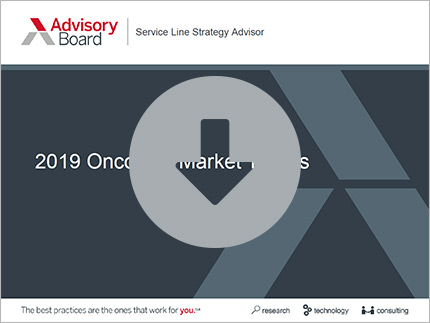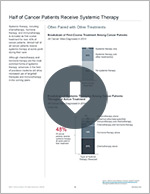Even though cancer-related deaths are on the decline in the United States, hundreds of thousands of people still die each year from cancers caused by potentially modifiable risk factors, according to a new research review by the American Cancer Society.
Next, see the latest clinical innovations in oncology
Review details
For the review, researchers examined data from a variety of population-based surveys—including the National Health Interview Survey, National Health and Nutrition Examination Survey, and the National Immunization Survey-Teen—to identify how many U.S. cancer deaths were linked with each of seven risk factors.
Smoking
In almost a third of all cancer-related deaths, the patient was a cigarette smoker, the researchers write. Despite the overall decline in tobacco use in the United States, some populations still have relatively high rates of smoking, the researchers found. For example, 30% of men with less than a high school education smoke, compared to just 5% of women with a college degree.
Obesity
In 2014, about 7% of all cancer-related deaths could be attributed to overweight or obesity, the researchers found. Between 2015 and 2016, about 36.5% of men and 26.9% of women were overweight, while 37.9% of men and 41.1% of women were obese.
When broken down by race, more than half of black women and Hispanic women were classified as obese, compared with 38% of white women. Racial differences in obesity rates were not as stark among men.
Alcohol consumption
About 4% of U.S. cancer deaths are attributable to alcohol, which the researchers wrote "increases the risk of mouth, pharynx, larynx, esophageal, liver, colorectum, and female breast cancers."
About 5% of both men and women reported heavy alcohol consumption, defined as more than 14 drinks per week for men or 7 drinks per day for women.
Poor diet
The researchers found that about 5% of U.S. cancer deaths are attributable to poor diet, which includes high intake of processed meats and red meats, as well as low intake of fruits and vegetables. For example, only about 16% of adults reported eating at least three servings of vegetables per day.
Variations in diet by education were wider among women than men, with just 12.5% of women with less than a high school education reporting eating at least three servings of vegetables a day, compared with 23.4% of women with a college degree.
Physical inactivity
An estimated 2% of all cancer-related deaths are attributable to a lack of physical activity, the researchers wrote.
In 2017, more than a quarter of adults reported having no leisure-time physical activity. This rate varied significantly by education, with almost half of people with less than a high school education reporting no leisure-time physical activity, compared with just 14.4% of college graduates.
HPV and other infections
Nearly all cervical cancers, 90% of anal cancers, about 70% of oropharyngeal cancers, and between 60 to 70% of vaginal, vulvar, and penile cancers are caused by persistent human papillomavirus (HPV) infection, the researchers wrote.
The HPV vaccine can prevent up to 90% of all HPV-related cancers, and while vaccination rates have been increasing, just 53.1% of girls and 44.3% of boys ages 13 to 17 were up to date with their HPV vaccination in 2017, the researchers found.
In all, infection with HPV—as well as other cancer-linked infectious agents, such as HIV and H. pylori—were responsible for about 3% of all cancer deaths.
Exposure to ultraviolet radiation
Ultraviolet radiation can cause melanomas, the researchers wrote, "which account for only about 1% of all skin cancer cases but the majority of skin cancer deaths." All told, ultraviolet radiation is responsible for about 1.5% of all cancer deaths.
One way that people are exposed to ultraviolet radiation is through indoor tanning devices, and the researchers reported that individuals who begin using such devices before the age of 35 are about 60% more likely to develop melanomas.
About 35% of both men and women reported having gotten a sunburn in the last year, according to the researchers.
Variations in cancer screening persist
Overall, cancer screening rates have been improving—but variations between populations still persist, the researchers found.
In 1987, just 29% of women at least 40 years old reported having a mammogram within the past two years—a number that increased to 70% in 2000 and 64% in 2015. However, mammogram rates varied noticeably by education, with 55% of women with less than a high school education reporting having a mammogram within the past two years, compared with 77.5% of college graduates.
Colorectal cancer screenings also have increased substantially, the researchers found. In 2000, fewer than 40% of people at least 50 years old received colorectal cancer screenings, compared to 62.6% in 2015 (Thielking, "Morning Rounds," STAT News, 4/3 [subscription required]; Sauer et al., Cancer Epidemiology, Biomarkers & Prevention, April 2019).
Next, see the latest clinical innovations in oncology
Find our take on the latest innovations in oncology and practices for maximizing a return on investment in our four research briefings.
Don't miss out on the latest Advisory Board insights
Create your free account to access 1 resource, including the latest research and webinars.
Want access without creating an account?
You have 1 free members-only resource remaining this month.
1 free members-only resources remaining
1 free members-only resources remaining
You've reached your limit of free insights
Become a member to access all of Advisory Board's resources, events, and experts
Never miss out on the latest innovative health care content tailored to you.
Benefits include:
You've reached your limit of free insights
Become a member to access all of Advisory Board's resources, events, and experts
Never miss out on the latest innovative health care content tailored to you.
Benefits include:
This content is available through your Curated Research partnership with Advisory Board. Click on ‘view this resource’ to read the full piece
Email ask@advisory.com to learn more
Click on ‘Become a Member’ to learn about the benefits of a Full-Access partnership with Advisory Board
Never miss out on the latest innovative health care content tailored to you.
Benefits Include:
This is for members only. Learn more.
Click on ‘Become a Member’ to learn about the benefits of a Full-Access partnership with Advisory Board
Never miss out on the latest innovative health care content tailored to you.


